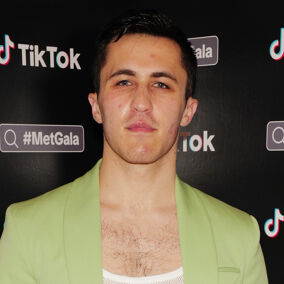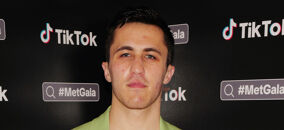The following in an excerpt from How To Love Someone Without Losing Your Mind by Todd Baratz, available now from Rodale Books. This brutally honest guide to dating, sex, and love from the creator of the viral Instagram account YourDiagnonsense offers a more inclusive and authentic perspective on building connections, delving into Todd’s experiences as a sex and relationship therapist and his own dating life as a gay man.

Here’s a rule you can keep in your back pocket: Stop looking for “the one.”
Everyone goes on dates armed with a list of needs, desires, and expectations. We know what we want in a partner with regard to their height, weight, career, and clothing style. Why are we doing this? Because we believe that this will allow us to build the best relationship with the least amount of difficulty and pain. Unfortunately, this kind of curated search for love makes it impossible for us to truly connect.
How about we take this to the next level?
Subscribe to our newsletter for a refreshing cocktail (or mocktail) of LGBTQ+ entertainment and pop culture, served up with a side of eye-candy.
The current culture around dating is a mess, a real problem. Most people approach dating without any information about how to develop a relationship. Instead, their focus is on seeking excitement, chemistry, or “the spark.” The One. It’s why more and more people have become avoidant, distant, and deeply alone. Many others have become resolute in their single lives, declaring that they don’t need a partner to complete them.
Dating in today’s world presents a unique set of challenges that were absent for past generations. We now have online dating, with myriad apps promising love or, at the very least, a connection. Each platform presents the same pool of singles within a fifty-mile radius, all available at the swipe of a finger. A simple swipe, tap, or “like” has become the new way of saying, “You’re hot.”
But with these advancements have come setbacks. The heartbreak of being ignored, left on “Read,” or ghosted is all too familiar. Then there are the dates that go awry, where you find that the person sitting across from you hardly resembles their curated online photos. Perhaps they have body odor, or bad breath, or make odd noises that weren’t apparent over text. But perhaps the most disheartening of all? Engaging in wonderful conversations that span days, or even weeks, feeling a genuine connection, only to be met with silence, never hearing from the person again.
This is dating today. It can be wildly exhausting and devoid of hope, yet it is a necessary evil if you’re looking for something meaningful. Kind of like eating when you’re not hungry: You just have to do it.
Most people who are on the dating treadmill end up fearful, guarded, and cold. They are freaked out about their value, the possibility of rejection, and generally anxious to the point where they struggle to communicate their feelings. This translates into the exact opposite of chemistry: disconnection. So, how can we expect to show up on yet another first date and be 100 percent ourselves? It’s just not going to happen.
During the first few dates, people often experience heightened anxiety. These initial encounters are defined by assumptions about the other person based on a dating profile or an Instagram feed. Being present has been replaced with one part intellectual analysis and two parts urgent hypervigilance. The result? Instead of being present on that first date, really listening and learning, we’re on high alert, trying to decipher how much the other person sitting across from us will one day hurt us. I call this the hurt potential. The hurt potential is a future-focused process defined by the “what ifs.”
“What if we’re incompatible because they like to go out and I’m a homebody?”
“Is it a red flag if they still talk to their ex? What if they haven’t moved on?”
“What if they judge me for struggling at work? I will focus on the positive.”
“What if they’re not family oriented? They said they don’t have a close relationship with theirs . . .”
Translation: “What if _________ is a problem, and I get hurt?” This is not what it means to be present; this is what it means to be fearful. The result? A lack of vulnerability and an increase in levels of the stress hormones cortisol and adrenaline, which will prevent you from being present.
Now imagine that you have finally found your “knight in shining armor.” You’ve determined that, with this person, the potential for love outweighs the potential for hurt. Well, get ready, because at some point down the line, the honeymoon phase will end, and the person you put up on that pedestal will massively disappoint you. Then, suddenly, your once-hopeful expectations will warp into an ugly combination of resentment and contempt.
By no means am I discouraging expectations, dreams, or desires for your future or current boo. Have them. Dream and fantasize. But be sure to make a big distinction between your dreams and the reality of life and love.
Let me break it down for you. We each carry a set of relationship rules that are shaped and defined by our culture and religion. They tell us how to proceed with our relationships, including everything from talking to an ex to opinions about age differences as well as determining the timing of moving in together, getting married, and starting a family. We internalize these guidelines as absolute truths, using them as our guiding compass in life to protect our hearts.
However, here’s the catch: These rules and cultural norms aren’t based on concrete facts, nor are they universally applicable. They are products of their respective times, and they have evolved over the years. That’s why I encourage you to explore your own family’s experiences. Rules are essentially societal norms, and they shift and transform as our culture does.
When looking for love, we create lists of qualities we seek in a partner. We feel entitled to constant validation. We want our partners to make us a priority, even when we fail to do the same for ourselves. We expect our partners to satisfy all our needs, and every one of their missteps triggers anxiety. We expect our partner to change the habits, behaviors, or personality traits we find inconvenient or irritating—just because we told them to (once or twice). We want constant attention from our partner, viewing their dedication to any other interest or personal challenge as a sign of disinterest in us.
While totally reasonable wishes, these are all unrealistic expectations. The largeness of the emotion driving us to get our needs fulfilled often mirrors the pain we experienced in
early childhood, when those needs weren’t met. But as adults, in mature relationships, we don’t actually need these things, especially not from our partners. I know as well as you how easy it is to become fixated on a specific trait or limitation in a partner while discounting the contexts and dynamics that created that trait or limitation in the first place.
While in session, to develop a more nuanced and complex understanding (without judgment, of course) of my clients’ lives, I help my clients unravel the psychological and cultural contexts that shape their experience. Deepened self-awareness drives change and personal growth. But personal growth is about more than just gathering information or gaining insight; it’s about training ourselves to shift from judgment to understanding. When we judge, we limit our potential for growth. Conversely, when we refrain from judgment, create a meaningful narrative, and appreciate complexity, we open ourselves up to more opportunities for personal development and self-improvement.
Context is everything. Don’t ignore the bigger picture. Context is the who, what, when, where, and why of your life. Think of context—or your life—as a garden. Everything influences how that garden flourishes. Just as the atmosphere and soil play a role in the garden’s growth, every detail of your life contributes to shaping who you are.
Factors like where you were raised, family dynamics, and finances all play a part. Your identity (think gender, race, ethnicity, and culture of origin) mediates how everything in your life develops. Challenges like health issues or even just a lack of sleep can drastically affect your well-being and relationships. So, just as in a garden, where each element has a purpose and consequences, in life, literally everything matters.
Few of us approach our lives and relationships with such an expansive understanding, but doing so is crucial. This is particularly relevant when considering how profoundly marginalized groups like BIPOC (Black, Indigenous, and other people of color), LGBTQ+, and those with disabilities experience their lives. These folks frequently navigate complex layers of challenges. Racism, homophobia, transphobia, sexism, and ableism continue to exist in most environments across the world. These hostile spaces destroy one’s feelings of self-worth. Lacking a feeling of acceptance and safety will influence all aspects of life, from one’s relationships and sex life to one’s career trajectory. These doubts and fears rest beneath the surface of our conscious understanding, where they quietly, yet powerfully shape our lives in ways we may not always notice.
We each bring to the table our unique histories, contexts, and varied needs in our relationships. These elements connect to everything in our lives, from childhood traumas to toxic cultural value systems and beyond. Seek out these nuances and complexities that define your relationship. Embrace the layers of the unknown and buckle up for the ride. This is part of what makes life satisfying and, yes, a bit scary, too.
As you begin applying these insights to your past, present, and future relationships, you will start rebuilding and reshaping your relational guidelines. This process may seem daunting, but trust me, it’s a rewarding endeavor that will make your life and love all the more enriching.
Excerpted from How To Love Someone Without Losing Your Mind by Todd Baratz. Copyright © 2024 by Todd Baratz. Used by permission of Rodale Books, an imprint of Random House, a division of Penguin Random House LLC, New York. All rights reserved. No part of this excerpt may be reproduced or reprinted without permission in writing from the publisher.
Don't forget to share:









































